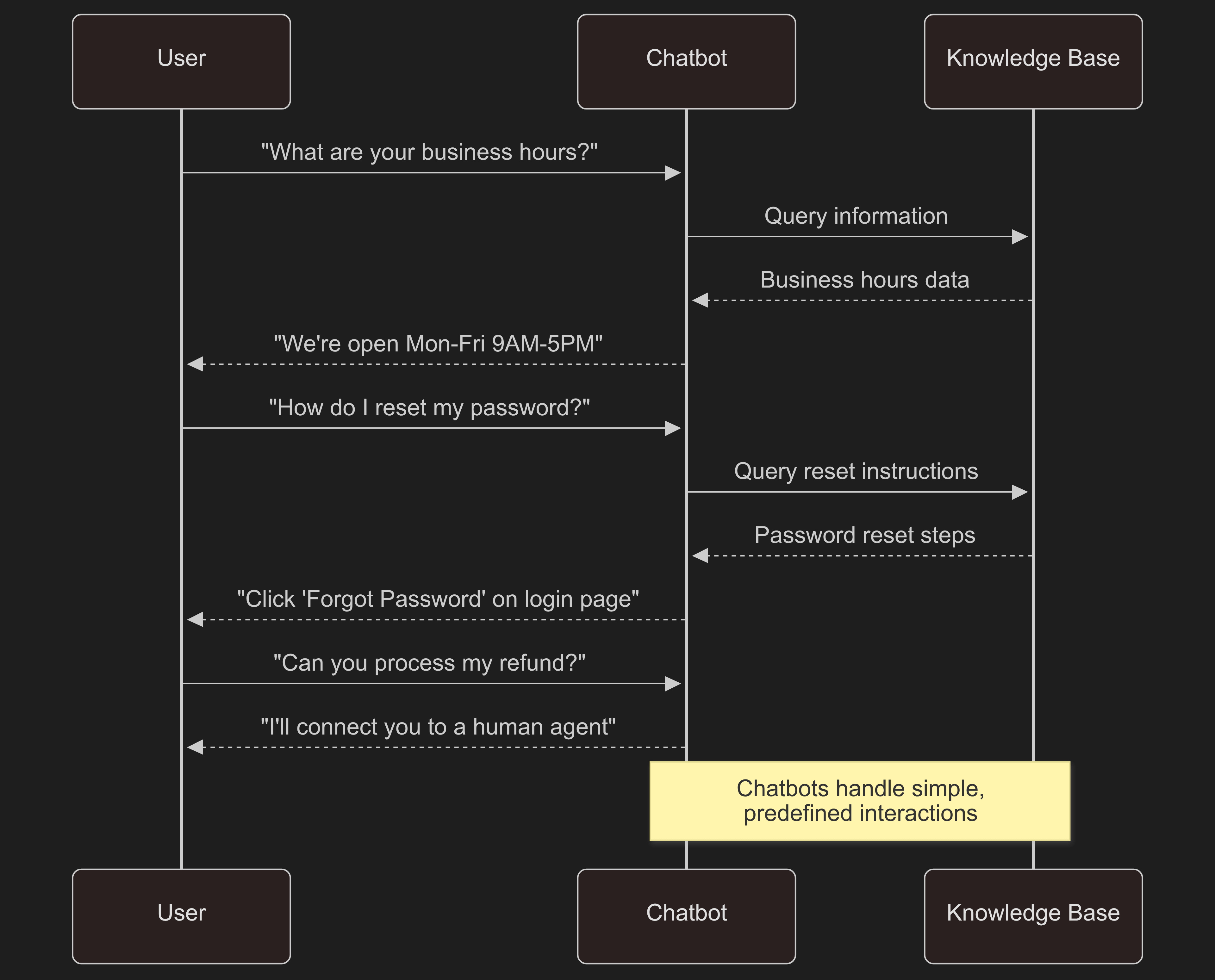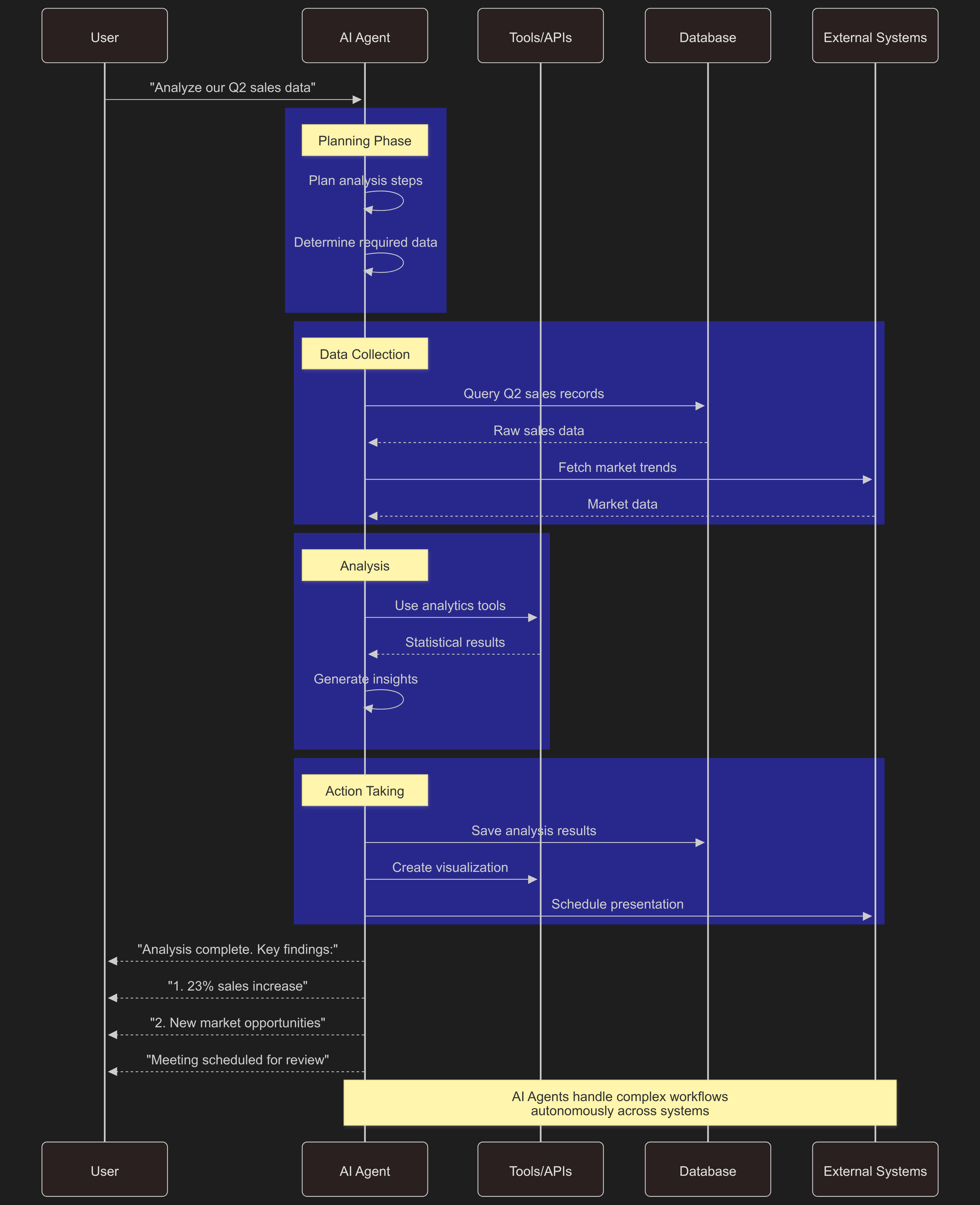AI Agent vs Chatbot: What's the Difference?
In today's AI world, most get mixed up between "chatbots" and "AI agents." They might look similar but operate differently. It is important for developers and businesses to understand the difference to choose a suitable solution.
Let us see what they do and how you must utilize them.
Chatbot vs AI Agent Comparison
Click on a system type to see detailed comparison
Traditional Chatbot
ChatbotModern AI Agent
AI AgentSelect a system above to view detailed comparison
What is a Chatbot?
A chatbot is a computer program that has a conversation with users through text or voice. Think of it as a virtual assistant that talks and answers queries.
Chatbot Types
Rule-based chatbots are rule-based. They can respond to specific keywords or phrases only. If you ask them something they are not aware of, they get confused.
AI-powered chatbots use machine learning to understand what you're attempting to communicate. They're smarter and are able to handle more types of questions, but they're still essentially built for conversation.
What Chatbots Do Best
Chatbots excel at handling routine communication tasks. They can answer frequently asked questions without getting tired or making mistakes. Many businesses use them for customer support because they can help multiple users at the same time.

They're also great at guiding users through simple processes, like filling out forms or finding basic information. When you need quick answers to common questions, chatbots can provide information instantly, any time of day.
What is an AI Agent?
An AI agent is much more than a chatbot. It's a intelligent program that thinks, plans, and acts to accomplish goals. Unlike chatbots that simply respond to what you type in, AI agents have the ability to act on their own.
Key Features of AI Agents
There are a number of key features of AI agents that separate them from simple chatbots. They are goal-directed, which means they head towards the accomplishment of specific objectives rather than simply responding to questions. They can be autonomous, generating decisions on their own without needing human input at every stage.
Unlike talkative chatbots, AI agents can take real actions by making use of tools and carrying out genuine tasks in other systems. Most importantly, they have learning capabilities that allow them to get better over time for what works and what doesn't.
What AI Agents Do Best
AI agents are best at performing complex work that has lots of steps and decisions. They can take entire workflows from start to finish and manage all the details in between. When given problems that involve several steps, they can break them down, solve each part, and combine everything for a solution.

AI agents are also extremely capable of bringing different systems together, moving data from one program to another and making everything work in harmony. Most importantly, they can do all of this independently without the need for constant supervision, freeing up humans to focus on more strategic and creative tasks.
Key Differences
1. How They Work
Chatbots are reactive. They wait around for you to pose a question, then react. It's like having a conversation with an expert individual who can only reply to questions.
AI Agents are proactive. They can start tasks, make decisions, and act toward objectives without being instructed to do so.
2. What They Can Do
Chatbots are limited to conversation. They can:
- Reply to questions
- Provide information
- Guide through basic processes
AI Agents can do much more. They can:
- Use multiple tools
- Sign in to multiple systems
- Complete complex workflows
- Make decisions based on data
3. Learning and Improvement
Chatbots learn from conversation to enhance comprehension and response.
AI Agents learn from activity and result. They can adjust strategies and improve how they get things done.
4. Integration
Chatbots will typically function as standalone systems or with simple integrations.
AI Agents can integrate closely with other systems, databases, and APIs to get work done.
Building AI Agents with VoltAgent
What is VoltAgent?
VoltAgent is an open-source platform that makes it easy to build AI agents. Instead of starting from scratch, developers can leverage VoltAgent to build powerful AI agents in no time.
Why VoltAgent is Different
Other chatbot platforms are focused on conversation. VoltAgent is focused on action. It provides:
- Tool Integration: Easy integration with services and APIs
- Memory Management: Agents remember past interactions
- Workflow Support: Handle complex, multi-step processes
- Multiple AI Providers: Integrate with different AI models
Getting started with the framework is kept simple:
- npm
- yarn
- pnpm
npm create voltagent-app@latest my-ai-app
yarn create voltagent-app my-ai-app
pnpm create voltagent-app my-ai-app
The CLI guides you through the setup process:
- Project name selection
- AI Provider choice (OpenAI, Anthropic, Google, Groq, etc.)
- API Key setup (optional)
- Package manager selection
- IDE configuration
After setup is complete:
cd my-ai-app
npm run dev
You'll see the VoltAgent server startup message in your terminal:
══════════════════════════════════════════════════
VOLTAGENT SERVER STARTED SUCCESSFULLY
══════════════════════════════════════════════════
✓ HTTP Server: http://localhost:3141
VoltOps Platform: https://console.voltagent.dev
══════════════════════════════════════════════════

When to Use Each
Use a Chatbot When:
- You need simple question-and-answer functionality
- Budget is an issue
- Needs are small
- You want something quick to deploy
- Risk tolerance is low
Use an AI Agent When:
- You need to automate complex workflows
- Multiple systems need to coordinate with one another
- Decision-making is needed for tasks
- Autonomous operation is wanted
- You are prepared to invest in more complex development
Advantages and Disadvantages
Chatbots
Advantages:
- Easy and quick to develop
- Cheaper
- Behavior can be predicted
- Less risky
Disadvantages:
- Limited in function
- Can't carry out complex tasks
- Need human intervention for challenging issues
- Limited learning ability
AI Agents
Advantages:
- Highly capable and flexible
- Can run independently
- Carry out complex tasks
- Scale well for big operations
Disadvantages:
- More difficult to develop
- More costly initially
- Need careful monitoring
- Require greater technical expertise
Real-World Examples
Chatbot Examples
- Customer service bots that answer frequently asked questions
- Shopping assistants that help in product finding
- Booking systems that schedule appointments
- FAQ bots that provide information
AI Agent Examples
- Sales agents that qualify leads and schedule appointments
- Data analysis agents that create reports automatically
- Integration agents that sync data between systems
- Monitoring agents that watch systems and fix problems
The Future
AI agents and chatbots are only going to improve. We're seeing:
- More intelligent, more helpful chatbots
- Easier-to-develop, easier-to-deploy AI agents
- Environments like VoltAgent making agent development mainstream
- More businesses adopting both technologies together
VoltAgent is opening up AI agents to more developers with simple-to-use tools and simple examples.
Conclusion
Chatbots and AI agents serve different purposes:
- Chatbots are ideal for conversation and simple tasks
- AI agents are ideal for complex, independent tasks
It all depends on your objectives, budget, and requirements. For simple interactions, a chatbot would be great. For complex automation, an AI agent built with tools like VoltAgent could transform your company.
There is a place for each technology, and understanding the difference enables you to make the right choice for your use case.